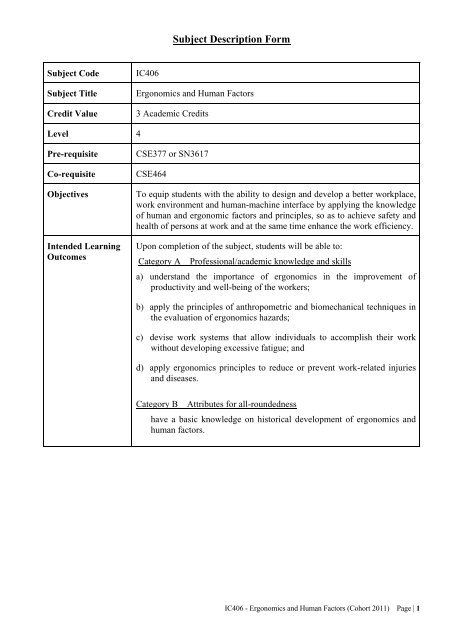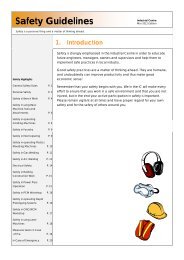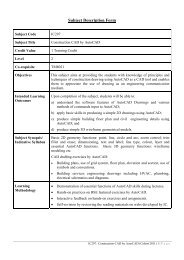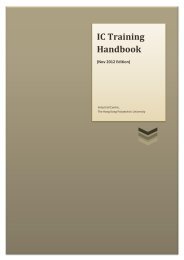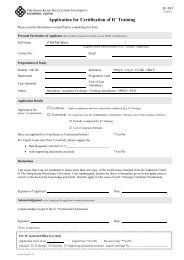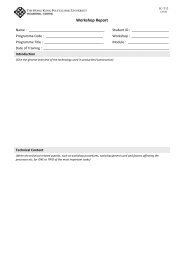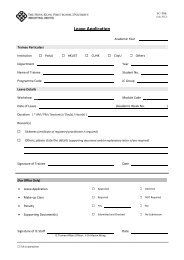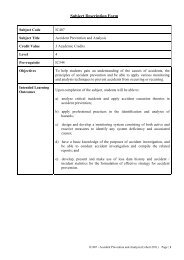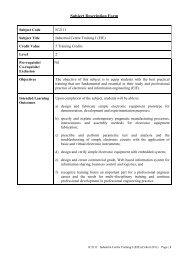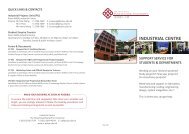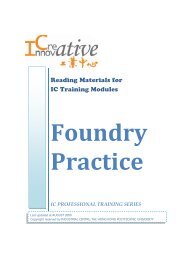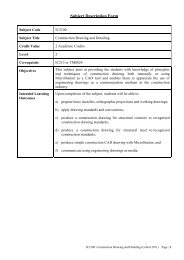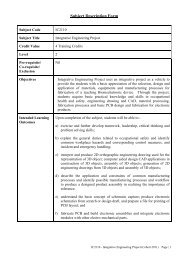IC406-Ergonomics and Human Factors
IC406-Ergonomics and Human Factors
IC406-Ergonomics and Human Factors
Create successful ePaper yourself
Turn your PDF publications into a flip-book with our unique Google optimized e-Paper software.
Subject Description Form<br />
Subject Code<br />
Subject Title<br />
Credit Value<br />
<strong>IC406</strong><br />
<strong>Ergonomics</strong> <strong>and</strong> <strong>Human</strong> <strong>Factors</strong><br />
3 Academic Credits<br />
Level 4<br />
Pre-requisite<br />
Co-requisite<br />
Objectives<br />
Intended Learning<br />
Outcomes<br />
CSE377 or SN3617<br />
CSE464<br />
To equip students with the ability to design <strong>and</strong> develop a better workplace,<br />
work environment <strong>and</strong> human-machine interface by applying the knowledge<br />
of human <strong>and</strong> ergonomic factors <strong>and</strong> principles, so as to achieve safety <strong>and</strong><br />
health of persons at work <strong>and</strong> at the same time enhance the work efficiency.<br />
Upon completion of the subject, students will be able to:<br />
Category A Professional/academic knowledge <strong>and</strong> skills<br />
a) underst<strong>and</strong> the importance of ergonomics in the improvement of<br />
productivity <strong>and</strong> well-being of the workers;<br />
b) apply the principles of anthropometric <strong>and</strong> biomechanical techniques in<br />
the evaluation of ergonomics hazards;<br />
c) devise work systems that allow individuals to accomplish their work<br />
without developing excessive fatigue; <strong>and</strong><br />
d) apply ergonomics principles to reduce or prevent work-related injuries<br />
<strong>and</strong> diseases.<br />
Category B<br />
Attributes for all-roundedness<br />
have a basic knowledge on historical development of ergonomics <strong>and</strong><br />
human factors.<br />
<strong>IC406</strong> - <strong>Ergonomics</strong> <strong>and</strong> <strong>Human</strong> <strong>Factors</strong> (Cohort 2011) Page | 1
Subject Synopsis/<br />
Indicative Syllabus<br />
1) Introduction<br />
A brief history of ergonomics <strong>and</strong> human factors including their<br />
definitions. Introduction to common ergonomic hazards <strong>and</strong> illnesses.<br />
Introduction to the principles of ergonomics <strong>and</strong> the areas of<br />
applications.<br />
2) Anatomy <strong>and</strong> Physiology as Applied to Work<br />
Anthropometry: anthropometric data, statistical concepts <strong>and</strong><br />
anthropometric applications. Biomechanics: biomechanical<br />
classification of movements; physiological <strong>and</strong> operational categories of<br />
movement. Anthropometric <strong>and</strong> biomechanical techniques applied to<br />
ergonomic hazard analysis <strong>and</strong> control.<br />
3) Work Physiology <strong>and</strong> Shift Work<br />
Physiological response. Energy <strong>and</strong> energy sources of the body.<br />
Categories of work. Physical work capacity. Fatigue <strong>and</strong> its evaluation.<br />
Classification of workload. Endurance in physical work <strong>and</strong> work-rest<br />
scheduling.<br />
4) <strong>Human</strong> Information Processing<br />
Physiological mechanism in human information processing. Model of<br />
human information processing. Mental workload. Sensation <strong>and</strong><br />
perception. Methods to improve ability of information processing.<br />
Attention. Signal detection.<br />
5) Interaction with the Environment<br />
<strong>Human</strong> senses <strong>and</strong> the physiological mechanisms. Homeostasis.<br />
Acclimatization. Hot <strong>and</strong> cold situations.<br />
6) Work Scheduling<br />
Body rhythms <strong>and</strong> individual differences. Sleep <strong>and</strong> sleep phases. Shift<br />
organization <strong>and</strong> patterns. Effects of shift work on workers. Guidelines<br />
for shift work. Criteria for selection of shift workers. Alternative work<br />
schedules.<br />
7) Design of Repetitive <strong>and</strong> Manual H<strong>and</strong>ling Tasks<br />
Introduction to work-related musculoskeletal disorders. The back <strong>and</strong><br />
neck problems. Cumulative trauma disorders (CTSs) in the upper<br />
extremities. Fundamental risk factors of CTDs. Prevention <strong>and</strong><br />
treatment of CTDs. Anatomy <strong>and</strong> biomechanics of manual h<strong>and</strong>ling.<br />
Prevention of manual h<strong>and</strong>ling injuries in the workplace. Design of<br />
manual h<strong>and</strong>ling tasks. Postural stability <strong>and</strong> postural control. Design of<br />
carrying tasks.<br />
8) Work-tool Design<br />
Grip strength <strong>and</strong> endurance. <strong>Ergonomics</strong> guidelines for h<strong>and</strong>-tool<br />
design. Safety guidelines for tool use. The workplace characteristics <strong>and</strong><br />
the worker’s functions. Design guidelines for controls <strong>and</strong> displays.<br />
9) Workstation Design <strong>and</strong> Office <strong>Ergonomics</strong><br />
Workstation design problems. Principles for workstation design.<br />
Ergonomic guidelines for seated workstations <strong>and</strong> st<strong>and</strong>ing tasks. Office<br />
health problems <strong>and</strong> solutions. Workstation design for office work,<br />
including display screen equipment user.<br />
<strong>IC406</strong> - <strong>Ergonomics</strong> <strong>and</strong> <strong>Human</strong> <strong>Factors</strong> (Cohort 2011) Page | 2
Learning<br />
Methodology<br />
The lecture will cover various ergonomic <strong>and</strong> human factors elements in the<br />
workplace <strong>and</strong> applications for achieving high efficiency <strong>and</strong> safety of<br />
work. Laboratory / field work will be incorporated where appropriate during<br />
the course of study. During the study, students are required to search for<br />
related literatures or articles to support what they have learnt. Continuous<br />
assessment may be in the form of essay, test <strong>and</strong> site visit report.<br />
Assessment<br />
Methods in<br />
Alignment with<br />
Intended Learning<br />
Outcomes<br />
Assessment Methods<br />
Weighting<br />
(%)<br />
Intended Learning<br />
Outcomes Assessed<br />
a b c d<br />
1. Essay, Test <strong>and</strong> Site<br />
Visit Report<br />
40 <br />
2. Examination 60 <br />
Total 100<br />
Continuous assessment in the form of essay, test <strong>and</strong> site visit report to<br />
assess students’ knowledge on Outcomes a, b, <strong>and</strong> d.<br />
Written examination is to test the underst<strong>and</strong>ing / application of principles<br />
related to Outcomes a to d.<br />
Student Study<br />
Effort Required<br />
Class Contact<br />
• Lecture 28 Hrs.<br />
• Tutorial / Site Visit 14 Hrs.<br />
Other Study Effort<br />
• Coursework 36 Hrs.<br />
Total Study Effort<br />
78 Hrs.<br />
<strong>IC406</strong> - <strong>Ergonomics</strong> <strong>and</strong> <strong>Human</strong> <strong>Factors</strong> (Cohort 2011) Page | 3
Reading List <strong>and</strong><br />
References<br />
Essential Textbook:<br />
1. Kroemer, K. H. E., Kroemer, H. B. <strong>and</strong> Kroemer-Elbert, K. E. (2000).<br />
<strong>Ergonomics</strong>: How to Design for Ease <strong>and</strong> Efficiency. (Second<br />
Edition). Englewood Cliffs, N.J: Prentice Hall.<br />
2. Bridger R. S. (2003). Introduction to <strong>Ergonomics</strong>. (Second Edition).<br />
London: Taylor & Francis.<br />
Reference Textbooks:<br />
1. Tayyari F. <strong>and</strong> Smith J. L. (1997). Occupational <strong>Ergonomics</strong>:<br />
Principles <strong>and</strong> Applications. London: Chapman & Hall.<br />
2. Oborne D. J. (1995). <strong>Ergonomics</strong> At Work. (3 rd Edition). Chichester:<br />
John Wiley & Sons.<br />
3. Karwowski W. <strong>and</strong> Marras W. S. (Editors). (2003). Occupational<br />
<strong>Ergonomics</strong>: Design <strong>and</strong> Management of Work Systems. Boca Raton:<br />
CRC Press.<br />
<strong>IC406</strong> - <strong>Ergonomics</strong> <strong>and</strong> <strong>Human</strong> <strong>Factors</strong> (Cohort 2011) Page | 4


